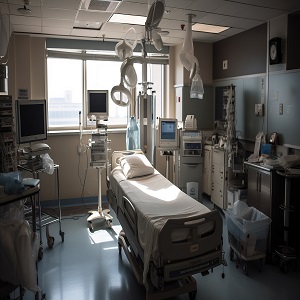Medical Bed Market Information:
The Medical Bed Market encompasses the production, distribution, and consumption of beds specifically designed for healthcare settings, including hospitals, nursing homes, and home care environments. These beds are equipped with features that enhance patient comfort, support medical procedures, and facilitate caregiving.The Medical Bed Market includes a diverse range of products designed to meet the needs of patients and healthcare providers.
Medical beds come in various types, such as electric beds, manual beds, and specialized beds for critical care or rehabilitation. They feature adjustable positions to aid in patient comfort and medical procedures. The market is driven by factors such as the increasing prevalence of chronic diseases, aging populations, and advancements in medical technology. As healthcare standards rise, there is a growing demand for beds that offer enhanced functionality, including remote control capabilities, pressure relief systems, and integrated monitoring devices.
Forecasts for the Medical Bed Market from 2024 to 2033 indicate steady growth, fueled by innovations in bed design and the expanding healthcare infrastructure. Key players in the market are focusing on developing advanced, ergonomically designed beds to improve patient outcomes and operational efficiency in medical facilities.
Get a Sample Copy of the Report to Know More: https://medicalmarketreport.com/report/global-medical-bed-market/#requestForSample
Key Takeaways:
Growing Demand:
The Medical Bed Market is expanding rapidly due to an increasing global population with chronic conditions and an aging demographic. This growth is also driven by the rising prevalence of hospital stays and long-term care needs.
Technological Advancements:
Modern medical beds come with advanced features such as electronic controls, adjustable positions, and integrated safety mechanisms. Innovations in this area include beds with built-in monitoring systems and pressure relief technologies to enhance patient comfort and care.
Diverse Product Range:
The market offers a variety of medical beds, including manual beds, electric beds, and specialty beds for different medical conditions. Each type caters to specific needs, such as adjustable heights for easy patient transfer or specialized features for critical care.
Rising Healthcare Investments:
Increased investments in healthcare infrastructure, including hospitals and nursing homes, are fueling demand for high-quality medical beds. As facilities aim to upgrade their equipment, there is a noticeable shift towards beds that combine functionality with ergonomic design.
Regional Growth:
While the Medical Bed Market is growing globally, significant expansion is seen in emerging economies due to improving healthcare systems and increased awareness about patient care. Developed regions also continue to invest in high-tech solutions and luxury healthcare facilities.
Patient-Centric Design:
There is a growing emphasis on designing beds that prioritize patient comfort and ease of use. Features such as memory foam mattresses, adjustable backrests, and easy-to-operate controls are becoming standard to improve the overall patient experience.
Market Competition:
The Medical Bed Market is competitive, with key players focusing on innovation and product differentiation. Companies are investing in research and development to introduce beds with advanced functionalities and smart technology integration.
Key Segmentation :
Type of Bed:
Manual Beds: Operated by hand cranks, these beds are cost-effective and commonly used in basic healthcare settings.
Electric Beds: Feature motorized controls for adjusting bed positions, offering greater convenience and comfort for both patients and caregivers.
Specialty Beds: Includes bariatric beds for heavier patients, ICU beds with advanced functionalities for critical care, and rehabilitative beds designed for recovery.
End-User:
Hospitals: Require beds with advanced features and high durability for a range of patient needs, from general wards to intensive care units.
Nursing Homes: Focus on beds that offer comfort and ease of use for elderly residents, including features like height adjustment and pressure relief.
Home Care: Medical beds designed for home use emphasize ease of adjustment and patient comfort, catering to those with chronic illnesses or disabilities.
Technology:
Smart Beds: Equipped with sensors and connectivity features for remote monitoring and data collection, enhancing patient care and safety.
Standard Beds: Basic models with essential functions, suitable for less demanding environments.
Region:
North America: Advanced market with high demand for high-tech beds and significant investments in healthcare infrastructure.
Europe: Growing market with a focus on innovative designs and aging population needs.
Asia-Pacific: Rapidly expanding market driven by increasing healthcare investments and rising awareness of patient care.
Rest of the World: Includes emerging markets where healthcare improvements are leading to greater demand for medical beds.
Material:
Metal Beds: Known for durability and strength, often used in hospitals and nursing homes.
Plastic Beds: Lightweight and easy to clean, suitable for home care and temporary settings.
Combination Beds: Utilize a mix of materials to balance durability, comfort, and cost.
Drivers:
The Medical Bed Market is primarily driven by an aging global population and increasing prevalence of chronic diseases. As the number of elderly individuals rises, there is a higher demand for medical beds in hospitals, nursing homes, and home care settings. Additionally, advancements in healthcare technology are propelling market growth. Modern medical beds come with features like electronic controls, pressure relief systems, and integrated monitoring devices that improve patient care and comfort. Increased investments in healthcare infrastructure and a growing emphasis on patient-centered care further drive the demand for advanced medical beds.
Trends:
A significant trend in the Medical Bed Market is the integration of smart technology. Smart beds equipped with sensors and connectivity features allow for remote monitoring and data collection, enhancing patient management and safety. Another trend is the development of beds that cater to specific needs, such as bariatric beds for heavier patients or beds designed for rehabilitation and recovery. The focus is also shifting towards ergonomic designs that improve both patient comfort and caregiver efficiency. Additionally, there is a growing preference for beds with modular and customizable features to meet diverse patient requirements.
Restraints:
The market faces several restraints, including high costs associated with advanced medical beds and limited budgets in some healthcare facilities, especially in emerging economies. The complexity of some beds can also pose challenges in terms of maintenance and training for healthcare staff. Regulatory requirements and safety standards can add to the cost and complexity of bringing new products to market, potentially slowing down innovation and adoption.
Opportunities:
The Medical Bed Market presents opportunities in expanding into emerging economies where healthcare infrastructure is rapidly developing. There is also potential for growth through the introduction of innovative, cost-effective solutions that cater to both high-tech and budget-conscious segments. Additionally, as telemedicine and remote patient monitoring become more prevalent, integrating these technologies into medical beds offers new avenues for market expansion and enhanced patient care.
Key Players Analysis:
- Home Instead Inc.
- Amedisys Inc.
- Kindred Healthcare LLC
- Seymour Health
- SENIOR CARE CENTERS OF AMERICA INC
- Other Key Players
If You Have Any Questions About This Report, Please Reach Out to Us https://medicalmarketreport.com/report/global-medical-bed-market/#inquiry
Conclusion:
In conclusion, the Medical Bed Market is experiencing significant growth driven by an aging population, rising chronic disease prevalence, and advancements in healthcare technology. The increasing demand for specialized and adjustable beds in hospitals, nursing homes, and home care settings highlights the market’s importance in improving patient comfort and care. Key players like Home Instead Inc., Amedisys Inc., Kindred Healthcare LLC, Seymour Health, and Senior Care Centers of America Inc. are at the forefront, using advanced technologies to meet diverse patient needs and enhance care delivery.Emerging trends such as smart beds with remote monitoring capabilities and ergonomic designs are shaping the market, offering new opportunities for innovation and growth.
contact us
Market.us (Powered By Prudour Pvt. Ltd.)
Address: 420 Lexington Avenue, Suite 300,
New York City, NY 10170, United States
Tel: +1 718 618 4351
Email:[email protected]



